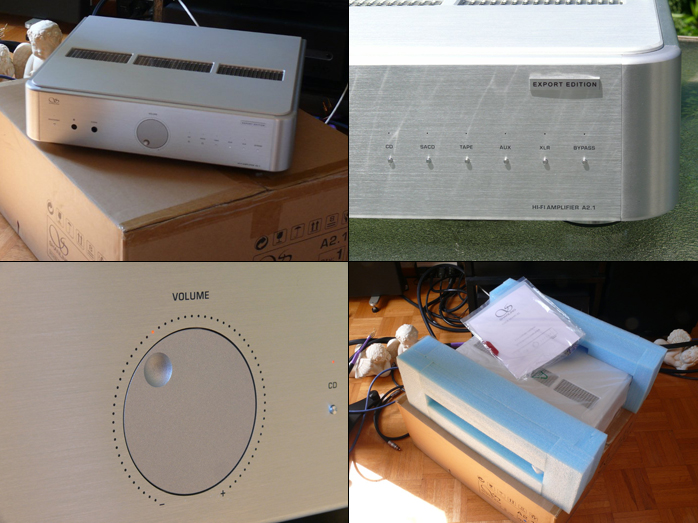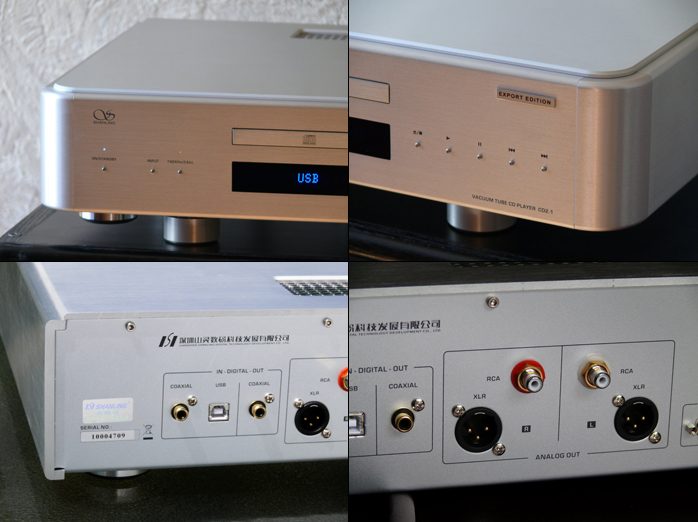This review page is supported in part by the sponsors whose ad banners are displayed below |
 |
 |
"Can Can Offenbach" from Top 12 in Gold Plus [GS DXD 001] is a Winston Ma sampler using 24/352.8kHz mastering and features a potpourri of various remastered offerings. This piece is a fun little free-for-all that lets the All Star Percussion Ensemble cut loose with dynamic fury and precision. Large soundstage, air and detail wonderfully recorded. A little bit of silly classical bombast to counter the dreaminess of Satie.
|
 |
"Simple Symphony for String Orchestra Op.4: Benjamin Britten" as a sample download [Divertimenti: Trondheim Soloists 2L] has already been reviewed and praised in these pages and is a lovely piece, detailed and dynamic with unusually warm strings in a rich dark acoustic. Accessible popular composition in a high-resolution format that’s solidly engineered and performed.
|
|
|
The CD player with its various outputs and upsampling options was a moving target. On a basic level the balanced outputs demonstrated standard virtues of solid state with flatter response, better transparency and a higher level of detail. The tube outputs were softer in the extremes and mildly veiled but with better midrange authenticity and solidity. Detail with the tube output was sufficient to be satisfying and applied to define soundstage information. The detail through the transistor output defined transients and dynamic gradation. Two viable choices. It should be stressed that the differences were subtler than in other designs. Shanling appears to approach tubes purely as alternate amplification devices and in pursuit of accuracy rather than euphony. As a result neither output strayed far from a core character which favors transparency and dynamics.
The 24/192 upsampling feature made definitive descriptions of the player more difficult. Where Audio Research eschews the upsampling capability of the PCM1792, Shanling made it a defeatable option. Combined with the tube and transistor paths it creates four flavors. The 2.1 is also a digital line source with the option of 24/192 pass through on the coaxial input and 24/96 for the USB (or the latter may be upsampled to 24/192). Depending on source and interconnects the permutations become quite endless. Rather than go into individual descriptions I concentrated on the common differences between upsampled and native signal. Regardless of source the two had distinct characteristics that were consistent through both tube and transistor outputs although those differences became more subtle with higher resolution material where the processing drew on more information to make its computational decisions.
|
 |
Engaging 24/192 upsampling made changes to all parameters. As with any change each listener will have to decide whether it constitutes a desirable alteration. 24/192 generated or reconstituted a large amount of additional information in the midrange and upper midrange by adding textural detail to the acoustic landscape. This worked best on acoustically dry material or lower-resolution files which were inherently deficient. It made those recordings a bit richer. On material which already contained a wealth of acoustic and spatial detail, it overwrote many of the music’s original cues. The additive information also changed the dynamic structure by slightly blunting transients and homogenizing dynamic contrast. The result was a gain in refinement at the expense of precision and dynamic life.
|
|
|
Soundstage information received a significant forward thrust in the midrange accompanied by an increase of focus in that region compared to the unprocessed signal. This resulted in an overall front-to-back expansion with a stronger sense of dimensionality. Frequency response was likewise affected in the midrange, adding more body, sweetening the top and gently rolling off extreme deep bass. The musicians had more front-hall perspective with an increase in tonal warmth. Disengaging upsampling made for a dramatic difference. The native signal was considerably more transparent with a higher level of dynamic contrast. It revealed a wealth of more subtle and cohesive low-level information. It was however comparatively drier especially through the transistor outputs. Images were not as pronounced or dimensional as the upsampled version. Midrange presentation was less forward and immersive. The perspective of the native signal was weighted towards critical observation, preserving depth cues with greater precision and presenting a clean and transparent acoustic environment. Where the tube output would traditionally reap benefits in texture and dimensionality, here the contributions were more subtle. They couldn’t match the tonal and spatial push which 24/192 injected. Soundstage information with native resolution vs. processed signal was more accurate overall but less intimate. Since the option can be turned on or defeated at the press of a button, it makes for an interesting exercise.
|
 |
Although a bit of a chameleon, the amp was at heart very much solid-state in flavor, demonstrating traditional strengths of a quite neutral response plus good bass control and power. It was sufficiently transparent to allow the different virtues of the source to pass without significant alteration and easily differentiated the high-frequency character between tube and transistor outputs of both Shanling and AudioSpace players. In the upper mids to highs the 2.1 showed a predisposition to achieving transparency by being a little cool and overtly extended. Cabling and source choice made the difference between accuracy or mild dryness. The midrange was clean but SS in character. Those favoring the warm midrange glow of tubes will find the Shanling a bit cool. Those preferring transistor precision will merely find it neutral.
The range of dynamics was surprisingly good if lacking the absolute fine gradations of the Densen B130+. In the differentiation between softest and loudest however, the Shanling rivaled the Densen by producing some spectacular swings. This was not confined to a specific portion of the spectrum. The unit exercised good transient behavior on material as varied as percussive bells or explosive bass. At low volume levels the 2.1 maintained transparency and dynamic agility in exemplary fashion by commanding listening attention. The Shanling proved "built for speed", clean and agile.
|
 |
  |
 |